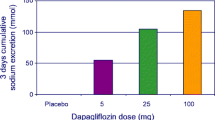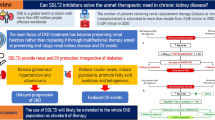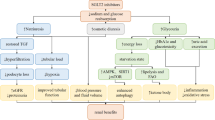Abstract
Diabetes induces glomerular hyperfiltration, affects kidney function, and may lead to chronic kidney diseases. A novel therapeutic treatment for diabetic patients targets the sodium–glucose cotransporter isoform 2 (SGLT2) in the kidney. SGLT2 inhibitors enhance urinary glucose, \(\hbox {Na}^+\) and fluid excretion and lower hyperglycemia in diabetes by inhibiting \(\hbox {Na}^+\) and glucose reabsorption along the proximal convoluted tubule. A goal of this study is to predict the effects of SGLT2 inhibitors in diabetic patients with and without chronic kidney diseases. To that end, we applied computational rat kidney models to assess how SGLT2 inhibition affects renal solute transport and metabolism when nephron population are normal or reduced (the latter simulates chronic kidney disease). The model predicts that SGLT2 inhibition induces glucosuria and natriuresis, with those effects enhanced in a remnant kidney. The model also predicts that the \(\hbox {Na}^+\) transport load and thus oxygen consumption of the S3 segment are increased under SGLT2 inhibition, a consequence that may increase the risk of hypoxia for that segment. To protect the vulnerable S3 segment, we explore dual SGLT2/SGLT1 inhibition and seek to determine the optimal combination that would yield sufficient urinary glucose excretion while limiting the metabolic load on the S3 segment. The model predicts that the optimal combination of SGLT2/SGLT1 inhibition lowers the oxygen requirements of key tubular segments, but decreases urine flow and \(\hbox {Na}^+\) excretion; the latter effect may limit the cardiovascular protection of the treatment.







Similar content being viewed by others
References
Baines A, Ho P (2002) Glucose stimulates O\(_2\) consumption, NOS, and Na/H exchange in diabetic rat proximal tubules. Am J Physiol Renal Physiol 283:F286–F293
Carmines P, Ohishi K, Ikenaga H (1996) Functional impairment of renal afferent arteriolar voltage-gated calcium channels in rats with diabetes mellitus. J Clin Invest 98(11):2564–2571
Chen J, Sgouralis I, Moore L, Layton H, Layton A (2011) A mathematical model of the myogenic response to systolic pressure in the afferent arteriole. Am J Physiol Renal Physiol 300:F669–F681
Cherney D, Perkins B, Soleymanlou N, Maione M, Lai V, Lee A, Fagan N, Woerle H, Johansen O, Broedl U, von Eynatten M (2014) Renal hemodynamic effect of sodium–glucose cotransporter 2 inhibition in patients with type 1 diabetes mellitus. Circulation 129:587–597
Edwards A, Layton A (2014) Calcium dynamics underlying the afferent arteriole myogenic response. Am J Physiol Renal Physiol 306:F34–F48
Eskandari S, Wright E, Loo D (2005) Kinetics of the reverse mode of the Na\(^+\)/glucose cotransporter. J Membr Biol 204:23–32
Evans R, Harrop G, Ngo J, Ow C, O’Connor P (2014) Basal renal oxygen consumption and the efficiency of oxygen utilization for sodium reabsorption. Am J Physiol Renal Physiol 306:F551–F560
Evans R, Ince C, Joles J, Smith D, May C, O’Connor P, Gardiner B (2013) Haemodynamic influences on kidney oxygenation: the clinical implications of integrative physiology. Clin Exp Pharmacol Physiol 40:106–122
Foley R, Collins A (2007) End-stage renal disease in the United States: an update from the United States Renal Data System. J Am Soc Nephrol 18:2644–2648
Fry B, Edwards A, Layton A (2015) Impacts of nitric oxide and superoxide on renal medullary oxygen transport and urine concentration. Am J Physiol Renal Physiol 308:F967–F980
Fry B, Edwards A, Layton A (2015) Impact of nitric-oxide-mediated vasodilation and oxidative stress on renal medullary oxygenation: a modeling study. Am J Physiol Renal Physiol 310:F237–F247
Fry B, Edwards A, Sgouralis I, Layton A (2014) Impact of renal medullary three-dimensional architecture on oxygen transport. Am J Physiol Renal Physiol 307:F263–F272
Garvin J (1990) Glucose absorption by isolated perfused rat proximal straight tubules. Am J Physiol Renal Physiol 259:F580–F586
Jauch P, Lauger P (1986) Electrogenic properties of the sodium-alanine cotransporter in pancreatic acinar cells: II. Comparison with transport models. J Membr Biol 94:117–127
Kim S, Heo N, Jung J, Son MJ, Jang H, Lee J, Oh Y, Na K, Joo K, Han J (2010) Changes in the sodium and potasssium transporters in the course of chronic renal failure. Nephron Physiol 115:31–41
Körner A, Eklöf AC, Celsi G, Aperia A (1994) Increased renal metabolism in diabetes: mechanism and functional implications. Diabetes 43:629–633
Layton A (2010) Feedback-mediated dynamics in a model of a compliant thick ascending limb. Math Biosci 228:185–194
Layton A (2011) A mathematical model of the urine concentrating mechanism in the rat renal medulla: I. Formulation and base-case results. Am J Physiol Renal Physiol 300:F356–F371
Layton A (2011) A mathematical model of the urine concentrating mechanism in the rat renal medulla: II. Functional impliciations of three-dimensional architecture. Am J Physiol Renal Physiol 300:F372–F394
Layton A (2015) Recent advances in renal hemodynamics: insights from bench experiments and computer simulations. Am J Physiol Renal Physiol 308:F951–F955
Layton A, Dantzler W, Pannabecker T (2012) Urine concentrating mechanism: impact of vascular and tubular architecture and a proposed descending limb urea-Na\(^+\) cotransporter. Am J Physiol Renal Physiol 302:F591–F605
Layton A, Edwards A, Vallon V (2017) Adaptive changes in GFR, tubular morphology and transport in subtotal nephrectomized kidneys: modeling and analysis. Am J Physiol Renal Physiol 313:F199–F209
Layton A, Laghmani K, Vallon V, Edwards A (2016) Solute transport and oxygen consumption along the nephrons: effects of Na\(^+\) transport inhibitors. Am J Physiol Renal Physiol 311:F1217–F1229
Layton A, Moore L, Layton H (2006) Multistability in tubuloglomerular feedback and spectral complexity in spontaneously hypertensive rats. Am J Physiol Renal Physiol 291:F79–F97
Layton A, Moore L, Layton H (2009) Multistable dynamics mediated by tubuloglomerular feedback in a model of coupled nephrons. Bull Math Biol 71:515–555
Layton A, Vallon V (2018) Cardiovascular benefits of SGLT2 inhibition in diabetes and chronic kidney diseases. Acta Physiol 222:e13050
Layton A, Vallon V (2018) SGLT2 inhibition in a kidney with reduced nephron number: modeling and analysis of solute transport and metabolism. Am J Physiol Renal Physiol 313:F969–F984
Layton A, Vallon V, Edwards A (2015) Modeling oxygen consumption in the proximal tubule: effects of NHE and SGLT2 inhibition. Am J Physiol Renal Physiol 308(12):F1343–F1357
Layton A, Vallon V, Edwards A (2016) A computational model for simulating solute transport and oxygen consumption along the nephron. Am J Physiol Renal Physiol 311:F1378–F1390
Layton A, Vallon V, Edwards A (2016) Predicted consequences of diabetes and SGLT inhibition on transport and oxygen consumption along a rat nephron. Am J Physiol Renal Physiol 310(11):F1269–F1283
Maki L, Keizer J (1995) Mathematical analysis of a proposed mechanism for oscillatory insulin secretion in perfused HIT-15 cells. Bull Math Bioll 57:569–591
O’Donnell M, Kasiske B, Daniels F, Keane W (1986) Effects of nephron loss on glomerular hemodynamic and morphology and diabetic rats. Diabetes 35:1011–1015
Oliva R, Bakris G (2014) Blood pressure effects of sodium-glucose co-transport 2 (SGLT2) inhibitors. J Am Soc Hypertens 8:330–339
Palm F, Cederberg J, Hansell P, Liss P, Carlsson P (2003) Reactive oxygen species cause diabetes-induced decrease in renal oxygen tension. Diabetologia 46:1153–1160
Palm F, Hansell P, Ronquist G, Waldenstrom A, Liss P, Carlsson P (2004) Polyol-pathway-dependent disturbances in renal medullary metabolism in experimental insulin-deficient diabetes mellitus in rats. Diabetologia 47:1223–1231
Parent L, Supplisson S, Loo D, Wright E (1992) Electrogenic properties of the cloned Na\(^+\)/glucose cotransporter: II. A transport model under nonrapid equilibrium conditions. J Membr Biol 125:63–79
Rich P (2003) The molecular machinery of Keilin’s respiratory chain. Biochem Soc Trans 6:1095–1105
Rieg T, Masuda T, Gerasimova M, Mayoux E, Platt K, Powell D, Thomson S, Koepsell H, Vallon V (2014) Increase in SGLT1-mediated transport explains renal glucose reabsorption during genetic and pharmacological SGLT2 inhibition in euglycemia. Am J Physiol Renal Physiol 306:F188–F193
Ryu H, Layton A (2012) Effect of tubular inhomogeneities on feedback-mediated dynamics of a model of a thick ascending limb. Med Math Biol 30:191–212
Sgouralis I, Layton A (2014) Theoretical assessment of renal autoregulatory mechanisms. Am J Physiol Renal Physiol 306:F1357–F1371
Sgouralis I, Layton A (2012) Autoregulation and conduction of vasomotor responses in a mathematical model of the rat afferent arteriole. Am J Physiol Renal Physiol 303:F229–F239
Sgouralis I, Layton A (2015) Mathematical modeling of renal hemodynamics in physiology and pathophysiology. Math Biosci 264:8–20
Thomson S, Rieg T, Miracle C, Mansoury H, Whaley J, Vallon V, Singh P (2012) Acute and chronic effects of SGLT2 blockade on glomerular and tubular function in the early diabetic rat. Am J Physiol Regul Int Comp Physiol 302:R75–R83
Vallon V, Gerasimova M, Rose M, Masuda T, Satriano J, Mayoux E, Koepsell H, Thomson S, Rieg T (2014) SGLT2 inhibitor empagliozin reduces renal growth and albuminuria in proportion to hyperglycemia and prevents glomerular hyperltration in diabetic Akita mice. Am J Physiol Renal Physiol 306:194–204
Vallon V, Rose M, Gerasimova M, Satriano J, Platt K, Koepsell H, Cunard R, Sharma K, Thomson S, Rieg T (2013) Knockout of Na-glucose transporter SGLT2 attenuates hyperglycemia and glomerular hyperfiltration but not kidney growth or injury in diabetes mellitus. Am J Physiol Renal Physiol 304:F156–F167
Welch WJ, Baumgartl H, Lubber D, Wilcox C (2001) Nephron pO2 and renal oxygen usage in the hypertensive rat kidney. Kidney Int. 59:230–237
Wright E, Loo D, Hirayama B (2011) Biology of human sodium glucose transporters. Physiol Rev 91:733–794
Author information
Authors and Affiliations
Corresponding author
Additional information
Communicated by Mette Olufsen.
This research was supported in part by the National Institutes of Health: National Institute of Diabetes and Digestive and Kidney Diseases, Grant R01DK106102 and by the Natural Sciences and Engineering Research Council of Canada (NSERC).
This article belongs to the Special Issue on Control Theory in Biology and Medicine. It derived from a workshop at the Mathematical Biosciences Institute, Ohio State University, Columbus, OH, USA.
Rights and permissions
About this article
Cite this article
Layton, A.T. Optimizing SGLT inhibitor treatment for diabetes with chronic kidney diseases. Biol Cybern 113, 139–148 (2019). https://doi.org/10.1007/s00422-018-0765-y
Received:
Accepted:
Published:
Issue Date:
DOI: https://doi.org/10.1007/s00422-018-0765-y




